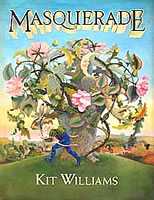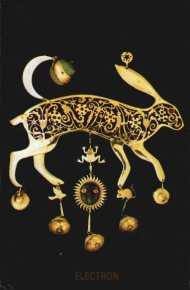Masquerade (book)

Masquerade is a children’s book, written and illustrated by Kit Williams, which sparked a treasure hunt by concealing clues to the location of a jeweled golden hare, created and hidden somewhere in Britain by Williams. It became the inspiration for a genre of books known today as armchair treasure hunts.
Book
Challenged by Tom Maschler, of the British publishing firm Jonathan Cape, to "do something no one has ever done before" with a children's book, Williams set out in the 1970s to create a book of paintings that readers would study carefully rather than flip through and discard. The book's objective, the hunt for a valuable treasure, became his means to this end. Masquerade featured 15 detailed paintings illustrating the story of a hare (named Jack Hare), who seeks to carry a treasure from the Moon (depicted as a woman) to her love object, the Sun (a man). On arriving at the sun, Jack finds he has lost the treasure, and the reader is left to find its location.
Along with creating the book, Williams crafted a hare from 18 carat (75%) gold and jewels, in the form of a large filigree pendant on a segmented chain. He sealed the hare inside a ceramic hare-shaped casket (both to protect the prize from the soil, and foil any attempts to locate the treasure with a metal detector). The casket was inscribed with the legend "I am the Keeper of the Jewel of MASQUERADE, which lies waiting safe inside me for You or Eternity".
On 7 August 1979, Williams (accompanied by celebrity witness Bamber Gascoigne) buried the casket at a secret location within England. Williams announced that his forthcoming book contained all clues necessary to decode the treasure's precise location "within a few inches." At the time, the only additional clue he provided was that it was buried on public property that could be easily accessed.
To ensure that readers from further afield had an equal chance of winning, Williams also announced that he would confirm the first precisely correct answer sent to him by post.
Kit Williams said:
- "If I was to spend two years on the 16 paintings for Masquerade I wanted them to mean something. I recalled how, as a child, I had come across 'treasure hunts' in which the puzzles were not exciting nor the treasure worth finding. So I decided to make a real treasure, of gold, bury it in the ground and paint real puzzles to lead people to it. The key was to be Catherine of Aragon's Cross at Ampthill, near Bedford, casting a shadow like the pointer of a sundial."
A modified version of the book also appeared in Italian, with a treasure buried in Italy (cf. Gascoigne, ch. 10). It was reinvented and translated by Joan Arnold and Lilli Denon with the name Il tesoro di Masquerade (Emme Edizioni).
Search
The book sold hundreds of thousands of copies worldwide, many in the United Kingdom, but also in Australia, South Africa, West Germany, Japan (where the book was called 仮面舞踏会 kamenbutoukai), France and the United States. Searchers often dug up public and private property acting on hunches. One location in England named “Haresfield Beacon” was a popular site for searchers, and Williams paid for the cost of a sign notifying searchers that the hare was not hidden on the premises. Real-life locations reproduced in the paintings were searched by treasure hunters, including Sudbury Hall in Derbyshire and Tewkesbury, Gloucestershire.
In March 1982, Kit Williams announced that Ken Thomas had won the contest. Bamber Gascoigne, having been asked by Williams to witness the burial of the hare and to document the contest from beginning to end, did so in his book Quest for the Golden Hare. Gascoigne summarized his experiences thus:
- "Tens of thousands of letters from Masqueraders have convinced me that the human mind has an equal capacity for pattern-matching and self-deception. While some addicts were busy cooking the riddle, others were more single-mindedly continuing their own pursuit of the hare quite regardless of the news that it had been found. Their own theories had come to seem so convincing that no exterior evidence could refute them. These most determined of Masqueraders may grudgingly have accepted that a hare of some sort was dug up at Ampthill, but they believed there would be another hare, or a better solution, awaiting them at their favourite spot. Kit would expect them to continue undismayed by the much publicised diversion at Ampthill and would be looking forward to the day when he would greet them as the real discoverers of the real puzzle of Masquerade. Optimistic expeditions were still setting out, with shovels and maps, throughout the summer of 1982."
Scandal
On December 11, 1988, The Sunday Times exposed the winner of the Masquerade contest as a fraud. The winner, "Ken Thomas", was revealed to be a pseudonym of Dugald Thompson. Thompson's business partner, John Guard, was the boyfriend of Veronica Robertson, a former live-in girlfriend of Williams. Guard had apparently convinced Robertson to help him because both were animal rights activists and Guard promised to donate any profits to the animal rights cause.
While living with Williams, Robertson had learned the approximate physical location of the hare, while remaining ignorant of the proper solution to the book’s master riddle. After finding out from Robertson that the hare was in Ampthill, Bedfordshire, Guard and two assistants started searching for it using metal detectors, an effort doomed to failure as Williams had sealed the jewel inside a clay casket specifically to foil such a discovery. After searching for some time, they drew a crude sketch of the location, which Thompson submitted to Williams as "Thomas." Williams recognised the sketch as the first correct solution mailed to him. Williams immediately phoned Thompson and instructed him to dig for the hare.
Only later did Williams discover that Thompson had not solved the puzzle in the intended manner, but appeared at the time to have blundered into a lucky guess. Shortly after Thompson was formally awarded the prize, the correct solution was unravelled by two physics teachers, Mike Barker of William Hulme's Grammar School and John Rousseau of Rossall School. Barker and Rousseau had actually unearthed the prize themselves, but had not noticed it inside its clay box; Thompson, who was loitering in the area, discovered it in the dirt piles they left behind.[1]

Williams was shocked to discover the scandal and is quoted as saying:
- "This tarnishes Masquerade and I'm shocked by what has emerged. I feel a deep sense of responsibility to all those many people who were genuinely looking for it. Although I didn't know it, it was a skeleton in my cupboard and I'm relieved it has come out."
Thompson founded a software company called “Haresoft”, and offered the jewel as a prize to a new contest which took the form of a computer game, Hareraiser. The company and its game (which many believe to be unsolvable with only meaningless text and graphics), were unsuccessful, yielding no winner. The hare was auctioned at Sotheby’s in December 1988, selling for £31,900 to an anonymous buyer. Williams himself went there to bid, but dropped out at £6,000.
The treasure’s whereabouts remained unknown for over 20 years, until it came to light in 2009. The BBC Radio 4 programme, The Grand Masquerade, broadcast 14 July 2009, told the story of the creation and solution of the puzzle.[2] Williams was interviewed and presenter John O'Farrell claimed that this was the first time Williams had talked about the scandal for 20 years. During the interview Williams expressed the desire to see the hare again. Hearing this, the granddaughter of the current owner arranged for Williams to be reunited briefly with his work. This was featured in a TV documentary, The Man Behind the Masquerade, which aired on BBC Four on 2 December 2009.[3]
The hare was on display at the V&A Museum, London, as part of its British Design 1948 - 2012 retrospective from March 31 to 12 August 2012.[4]
Solution
The solution to the Masquerade puzzle is elaborate. In each painting, lines should be drawn from each creature's left eye through the longest digit on their left hand to a letter in the border. Then from left eye through the longest digit on their left foot, right eye through the longest digit on their right hand and finally right eye through the longest digit on their right foot. This is only done for any eyes that are visible in the drawing. The resulting letters form individual words, revealed either by anagramming or by applying the order hinted at by the Sir Isaac Newton painting, in which all of the creatures of the book are represented as puppets hanging in a line from left to right.
Decoding and following this method reveals the nineteen-word message:
CATHERINE’S LONG FINGER OVER SHADOWS EARTH BURIED YELLOW AMULET MIDDAY POINTS THE HOUR IN LIGHT OF EQUINOX LOOK YOU
Taking the first letter indicated by each painting, the acrostic “CLOSE BY AMPTHILL” is revealed. Properly interpreted, the message told one to dig near the cross-shaped monument to Catherine of Aragon in Ampthill Park, at the precise spot touched by the tip of the monument’s shadow at the stroke of noon on the date of either the vernal or autumnal equinox.[5]
Many additional hints and "confirmers" are scattered throughout the book. For example, in the painting depicting the Sun and the Moon dancing around the Earth, the hands of the two figures are clasped together, pointing at the date of the spring equinox.
Legacy
Masquerade became the forerunner of an entire genre of cryptic puzzles known as armchair treasure hunts. It spawned a succession of books and games from other publishers seeking to emulate its success, including The Key To The Kingdom (Pavilion Books), The Piper Of Dreams (Hodder & Stoughton) and The Golden Key (William Maclellan), all of which were published in 1982. Similar hunts have continued to be published in various formats, with several current hunts making use of technologies that were unavailable at the time of Masquerade, such as Menagerie (an homage to Masquerade), which is web-based, and Text4Treasure, which uses SMS messaging. Others, such as Army Of Zero, follow Masquerade's use of physical media for the main puzzles, but provide additional clues on-line. − Beware the Sliverman, The Game of Reason, Imagination and Knowledge, released in 2008 begins with players having to find the gameboard from a Masquerade-inspired riddle. The gameboard is actually a c. 12th-century mosaic that is buried in a UK hill.
Notes and references
- ↑ "Masquerade Scam". Thefoolsparadise.com. 1988-12-11. Retrieved 2012-11-22.
- ↑
- ↑
- ↑ Michael, Apphia. "'British Design 1948-2012: Innovation in the Modern Age' at the V&A, London". Wallpaper.com. Retrieved 4 April 2012.
- ↑ 52°02′04″N 0°30′27″W / 52.034546°N 0.507536°W Coordinates of buried hare.
- ↑ "BBC Radio 4 - The Grand Masquerade". Bbc.co.uk. 2009-10-24. Retrieved 2012-11-22.
- ↑ Douglas, Torin (2009-08-20). "Entertainment | Arts & Culture | Artist reunited with golden hare". BBC News. Retrieved 2012-11-22.
Select bibliography
- Kit Williams, Masquerade, London: Jonathan Cape, 1979 (ISBN 0-8052-3747-X)
- Kit Williams, Masquerade: The Complete Book with the Answer Explained , London: Jonathan Cape, 1982 [paperback] (ISBN 0-89480-369-7)
- Bamber Gascoigne, Quest for the Golden Hare, London: Jonathan Cape, 1983 (ISBN 0-224-02116-8)
See also
- The Merlin Mystery, a similar book from 1998
- Treasure: In Search of the Golden Horse